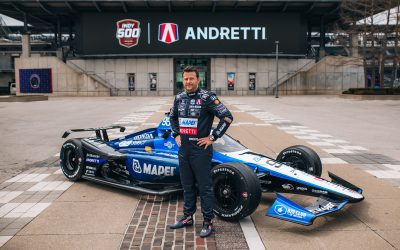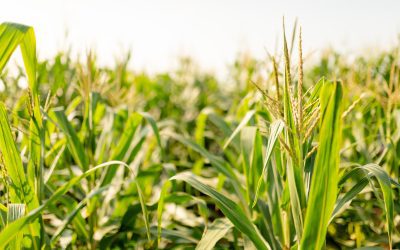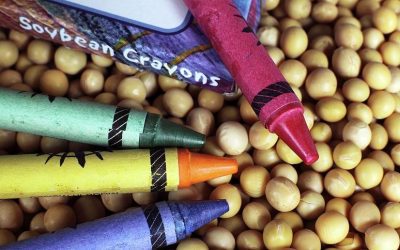INDIANAPOLIS, Ind. (Dec. 7, 2020) — Sharing the day-to-day details of life on a farm with those who are disconnected from farm life is a mission for the owners of Welker Farms. The final session of the week-long Indiana Corn and Soybean Forum featured YouTube sensation Welker Farms. Indiana Soybean Alliance (ISA) board member and Clay County, Ind., farmer Kevin Cox, who hosts the bi-weekly Movin’ The Pile podcast for ISA and the Indiana Corn Marketing Council (ICMC), interviewed the owners of Welker Farms from their Montana home.
The Forum is an annual event produced by the Indiana Soybean Alliance (ISA) and the Indiana Corn Growers Association (ICGA). This year’s Forum, due to COVID-19 restrictions, was virtual instead of in-person. Bane-Welker Farm Equipment and First Farmers Bank and Trust were the presenting sponsors for last week’s Forum.
Welker Farms has hundreds of thousands of followers on YouTube, and their audience continues to grow. Located in North Central Montana, the farm has been in the family since 1912. Third generation farmer, Bob Welker, along with his two sons, Nick Welker and Scott Welker, strive to carry on the family legacy. Using large machinery and the latest in technology, the Welkers manage 10,000 acres and grow spring wheat, winter wheat, yellow peas and garbanzo beans.
Welker Farms has become a common name throughout the agriculture world due to their YouTube channel, which began when Nick Welker thought it would be entertaining to celebrate the 100 anniversary of their family farm with a video. Since then, Welker Farms has attracted many faithful fans. But their YouTube and social media work has consumed much of their time. “It’s like a very hungry child,” Nick said. “The more you feed it, the more it grows. So that’s what we do right now. We just keep feeding it.”
He estimated that about 60 percent of their audience are farmers or people who grew up on a farm. “I think the majority of our audience is definitely farmers,” Nick said. “We have a very large following in the farming community.”
A significant segment of the Welkers’ audience have no connection to a farm. Nick said some of those viewers are fans of large farm equipment, which they frequently feature in their videos. Other viewers, though, are curious about regular life on a Montana farm. “This has become a kind of reality show,” Bob said of their broadcasts. “The fact that there are two videos a week, people see highlights of what we’re doing through the week. And I think that is good for all of the agricultural community. Farming is complex. There are so many things going on throughout the year. It’s not just going out there and kicking the dirt, seeding the ground and covering it up.”
Nick said that they receive some interesting and uninformed questions about agriculture from those who comment on their videos. But, he said, that gives Welker Farms the opportunity to explain how a farm works.
The Welkers are most often asked about how many acres they farm.
“It’s kind of like asking how many dollars you have in a bank account,” said Nick, who added that he now tells people that they farm 10,000 acres without waiting for the question. “Land doesn’t transition into money unless you sell it. That why it’s often said that farmers are land rich but cash poor – broke in the bank, but wealthy in the land. No one want to sell it, though, because when it’s gone, it’s gone.”
Bob Welker said he has mostly transitioned the leadership of the farm to his two sons. He admitted that’s it’s not been easy for him, but it has been the right thing to do. “In fact, it’s been a good transition,” Bob explained. “When I finally decided to release control, which can be kind of difficult as some ‘Dad’ farmers know, I realized (my sons) are as capable – or even more capable – than myself. So, I backed away, and it’s just been a joy to see them come in the fabric of the farm and put their ideas, their talent and their work into the farm and see the success.”
Bob said meeting farmers from across the country has been a highlight of their YouTube popularity. He said their videos include content for education, entertainment and cinematic photography of sunsets, equipment in the field and overhead drone footage of the farm.
Bob said parents don’t have to worry about allowing children to watch their videos. “We have accountability to our Lord, we have accountability to our families and we have accountability to our audience,” Bob said.
Scott Welker, who is known for being able to repair machinery, said there is little conflict on the farm. He said everyone knows their role on the farm, and each person works to their own strengths. Scott believes that comes through in the videos. “We want to be genuine. We don’t want to put up a front,” he said. “We don’t always get along, but most of the time we do.”
Nick said people interested in their videos can follow Welker Farms on YouTube, Instagram, Twitter and Facebook by going to their website welkerfarmsinc.com
The week-long Indiana Corn and Soybean Forum wrapped up with Friday’s webinar. The Forum is an event that highlights the policy work of the ICGA and ISA. Mike Koehne, a farmer from Greensburg, Ind., and the Chair of the ISA’s Membership and Policy Committee, encouraged viewers to become members of the policy organizations.
“The policy work that we do cannot be funded by checkoff money,” Koehne said. “We’re so busy on the farm sometimes that we can’t keep up with all of the policy discussions that might affect us. But we have a very good staff that keeps us informed of what’s going on. We’ve got to let legislators know what’s important to us.”
A one-year, joint membership for ICGA and ISA costs $150, and it includes additional membership and benefits to the American Soybean Association (ASA) and the National Corn Growers Association (NCGA). A one-year membership for ICGA costs $100, including a membership in NCGA. The one-year membership for ISA costs $70, including membership with ASA. Anyone interested in becoming a member should contact Rachel Conner at rconner@indianasoybean.com.
####
About Indiana Soybean Alliance Membership and Policy Committee: The ISA Membership and Policy Committee works to enhance the viability of Indiana soybean farmers through the advocacy and promotion of state and federal policies. ISA Membership and Policy Committee is led by members of the Indiana Soybean Alliance farmer board who are charged with directing advocacy efforts on behalf of more than 600 dues-paying members. Learn more at www.indianasoybean.com
About Indiana Corn Growers Association: The Indiana Corn Growers Association works with state and federal governments to develop and promote sound policies that benefit Indiana corn farmers. The ICGA consists of nine farmer-directors who provide leadership to the organization on behalf of more than 800 members statewide. Learn more at www.incorn.org/icga
This communication was NOT funded with Indiana corn and soybean checkoff dollars.



